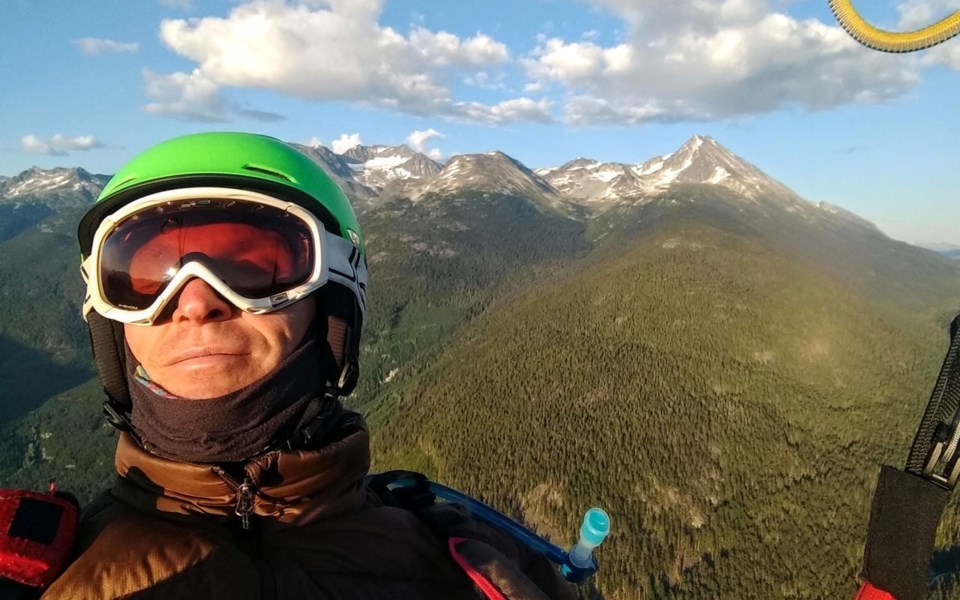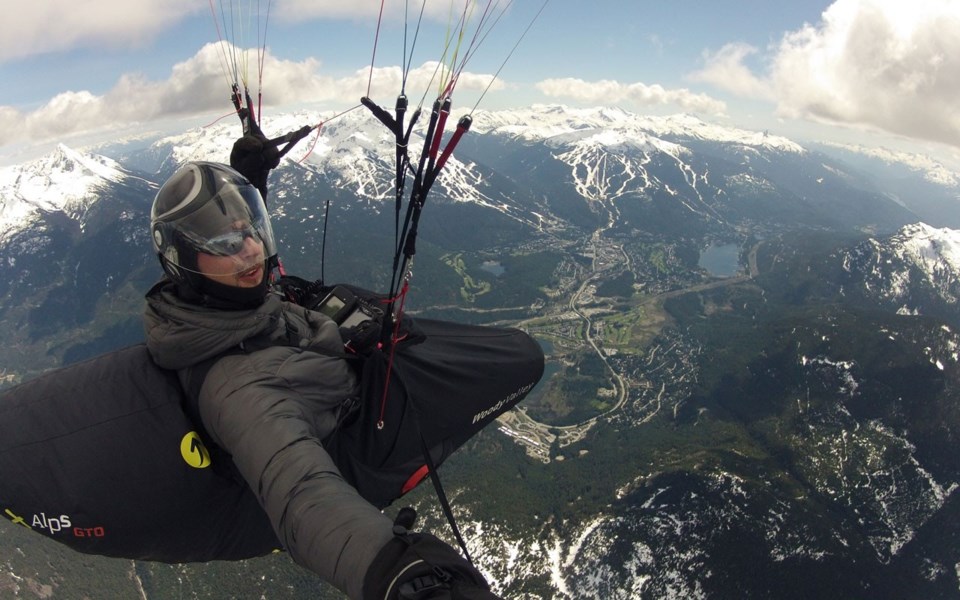When paraglider Alex Raymont launched from Rainbow Mountain the morning of July 22, he had planned to not only complete the first 200-kilometre triangle in Canada, but set a new national record in the process.
He did just that, completing a 213.24-km route over the course of nearly eight-and-a-half hours.
"To do the 200 in Canada is pretty cool. We knew it would eventually happen, it was just a matter of 'Can you do it and not feel like you're pushing?'—there's an element of danger. The route I did, I know pretty well. There were some deep moments but there weren't hours of flying without landing zones, without safety," said Raymont, who had previously completed a 200-km triangle in Europe, where other athletes have completed 300-km distances.
West Coast Soaring Club president Tyler Gillies noted in an email that the national record Raymont broke had stood for a decade, but Raymont himself was its holder for less than 48 hours. On July 24, his friend Igor Tolsky launched from Miller's Ridge near Pemberton and pulled off a 238.5-km triangle.

"To be honest, it didn't bother me at all. I was still recovering from my flight," Raymont said with a chuckle, noting he sent Tolsky an encouraging text as the record was about to fall. "I'm just totally happy that he's getting some of this weather as well. Up until that week, it had been a bad year. We hadn't really had much at all. It went from being a bad year to being the record year in a week."
For his part, Tolsky said he'd been waiting a while for anything resembling that day's conditions and knew he had to take advantage.
"It was in special weather. It doesn't happen very often," Tolsky said, noting there was a northerly wind that day. "This north wind brought Arctic air, which was cold, and it was pretty cold to fly at 3,000 metres.
"I was waiting for this kind of weather for a few years ... These few days, almost a week, was a special week to fly, and it happened, fortunately, just before the smoke, so everything worked out very well."
Tolsky saw Raymont set the record in ideal flying conditions, and then saw that the weather was set to stick around for a few more days.
"On my days off, I saw predictions and the conditions were very, very similar," said Tolsky, who later noted the glider he used was speedier than Raymont's. "I thought, 'OK, Alex had a great flight and with a similar day, why (shouldn't I) try?"
Tolsky explained the course he charted was one he'd had in the back of his mind for quite some time, and he was now finally presented with ample opportunity to complete it.
"I tried to do this unusual route that only a few people flew. It was always my dream to do (it), but it's kind of a challenging one. You have to have a special day to try to fly it because there's so much unlandable area. For 30 or 40 km, there wasn't any place to land," he said. "I just tried my best and was able to do it," said Tolsky, who began flying in his home country of Kyrgyzstan 20 years ago and moved to Canada 17 years ago.
Though the weather cooperated for Tolsky, a number of external factors didn't. In the days leading up to his record, he'd been waking up at 5 a.m. for work for several days prior and, in order to get to his launch spot on time by meeting a shuttle in Pemberton at 8 a.m., he had to be up at 4:30 a.m.
"It was a tough day," Tolsky said with a laugh. "But I was so determined to do it. I knew it was the best call, the best day to do it."
Tolsky subsequently tried to break his own record with a 250-km triangle, but smoke forced him to land before he completed the proper shape.
Making a plan
Raymont, a Â鶹´«Ã½Ó³»resident, said there's plenty of homework that goes into planning a flight, and he uses a program called XC Planner to prepare his day.
"I looked at the routes and the maps. I flew a bunch of sites over the years on the route and put it together," he said, noting he found the right permutations of transitions to travel the distance he did.
Another factor, of course, is the weather, which can pose myriad considerations for paragliders.
"Most people would be surprised to learn that cross-country paragliding is much more of an engineer's sport. There are quite a lot of engineers in our sport because it does favour an analytical mindset and cross-country flying is more like a game of chess—an aerial game of chess," he said. "You're trying to figure out where you can go. Is that cloud still working? Is that place still a place to ride? Where do I go from there?"
Tolsky uses a flight planner app to pre-plan his flights, determining not only the starting wind direction and ideal altitudes, but also accounting for necessary changes throughout the day.
"I try to use wind as my helper," he said. "I can see that in the morning time ... it's blowing this direction and then it changes 30 to 40 degrees during the day."
Both men added that developments in technology—in terms of the gliders themselves and in terms of wireless communication—have made the sport safer in the past decade. Tolsky said he can alert his family if he's landing in a remote spot, and carries food, water and camping supplies with him in case he needs to spend a night. He added, in two decades of participation, he's never suffered a worse injury than a sprained ankle.
Embracing the community
In addition to congratulating one another upon breaking records, the duo explained the paragliding community as a whole is tight-knit and always pushing its members to be better.
"I like that kind of vibe much more than holding my cards close to my chest," Raymont said.
Raymont added he regularly peruses the xcontest.org website, where he and numerous other paragliders post their results in detail.
"It's also an online contest. We'll compete against people in Canada and people in the world," he said. "I'll go on a launch in India and I'll know people from the online contest. I'll meet them and be, 'Oh, I've been seeing your flights in Switzerland' and we'll go flying together for a week there. It's kind of a weird mix of virtual reality and very real reality.
"You can put your flight out and people can see every turn you make, what time you took off, why did you go to Whistler at that time in the morning? Rainbow is an east-facing launch, so it starts earlier than the launch in Pemberton. If you want to do really big distance, the MacKenzie Basin Launch above Pemberton is a bit too late."



